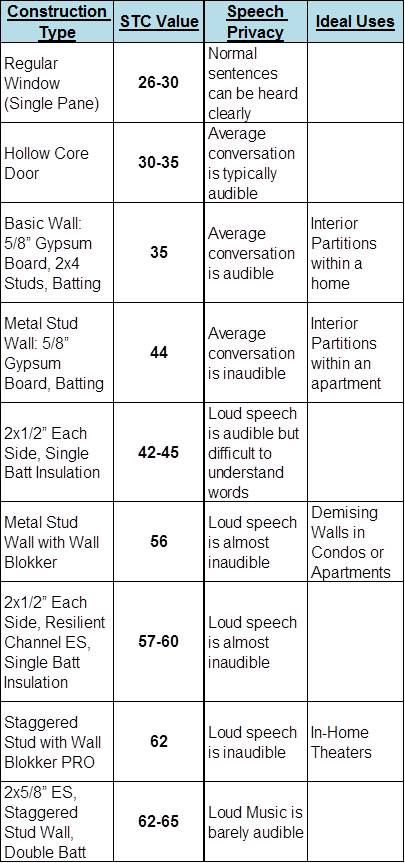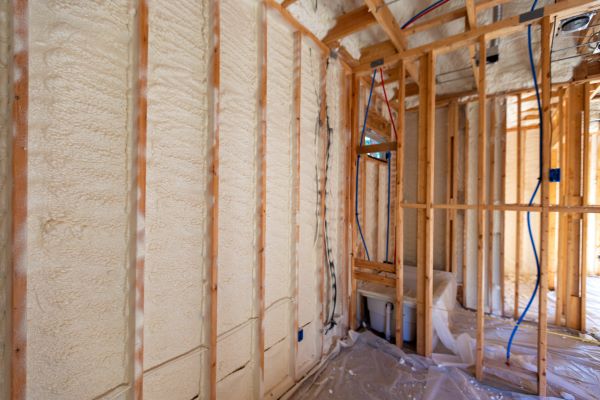When designing or building a wall partition, it’s critical to understand what benefits you’ll get out of the wall assembly, and the associated costs and complications that come with more complex assemblies. The first step is to determine target STCs – how much sound do you need your wall to block? This is often dependent on the use-case of the room, and the expectations of the tenants. Just as walls in a doctor’s office may vary with those of a daycare, you’ll also have different expectations at an affordable housing development than a high-end luxury condominium.
STC 50 Walls
The most common single rating search for across the internet is STC 50. That is because it is one of the few STC, or Sound Transmission Classification, ratings that are mandated by building code. Particularly, in the International Building Code, STC 50 is required for dwelling units to adjacencies.
This means that all apartments, condos, and other multi-family developments require an STC 50 rating in the wall! However, as is often seen during field STC testing, this rarely occurs. While condos are typically over-designed to ensure that STC 50 is reached and exceeded due to the significant litigation in the condo market, apartments are rarely tested and often fall below the minimum STC 50 rating.
It should be noted that this building code does not apply to hotels, offices, and other applications, which are instead generally designed per brand standards and acoustic best practices.
Remember that a standard wood stud wall has an STC of 35, while a metal stud wall (25 gauge) has an STC of 44. In order to achieve an STC of 50 and higher, you must stagger or double the studs (for wood stud walls), use a resilient mount (such as iso clips), and/or add multiple layers of soundproofing materials or drywall.
See How to Soundproof an Interior Wall
Wall STC Determination
There are numerous tools across the internet to calculate the STC of your wall design. Be sure to compare apples-to-apples, since some products may advertise an STC, but change the underlying wall assembly.
Below is a list of STC values for common partitions and assemblies, along with their estimated speech privacy and ideal applications in the real world. By utilizing soundproofing membranes and other material on the market, you can achieve these STCs at prices that weren’t previously possible with conventional construction methods.
High STCs may also be achieved by using a vinyl barrier (such as mass loaded vinyl) in the wall to improve soundproofing performance, especially with metal stud wall assemblies.

What is a Good STC Rating? Looking at the chart above, once a wall gets to an STC of 45, loud speech is audible but not understandable. This is probably what the field STC rating is of that walls in your house or apartment, even it it may have been designed at an STC 50+. When tested in the field, an STC rating of a wall assembly will almost always be lower than the lab test due to human error in the field.
Warning – STC is Not the Entire Answer
Remember that STC ratings are not the only determinant when deciding how to design a wall. An STC 50 wall may be sufficient for apartment-to-apartment, but may be well below the expectations of a high-end condo. Some litigation refers to “commercially reasonable” expectations of the clients. Somebody spending millions of dollars on a condo may expect to be able to listen to the stereo or TV without having to constantly apologize to neighbors.
Meanwhile, STC is really just an “approximation” of how much sound a wall blocks. It does not tell you the wall soundproofing ability at very low frequencies, which are not included in the STC calculation. Cinema soundproofing, for instance, must consider 50-80 Hz sound transmission, which may not be relevant in hospitality and multi-family applications. For unique applications, an acoustic engineer should be used to determine the appropriate STC and frequency-specific soundproofing needed for walls.




I’ve been thinking of looking into soundproofing some rooms. I’ve never heard of the airborne test of placing a loud speaker playing pink noise in the corner of a room and turning the volume up to at least 10 dB above the background noise in the receiving room, but it sounds like an excellent way to test the sound of the walls. I can imagine that testing the sound of the walls before you get them replaced would be very useful.